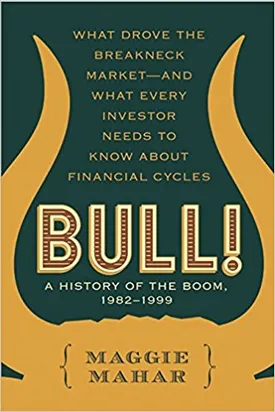Bull!: A History of the Boom, 1982-1999 by Maggie Mahar
Bull!: A History of the Boom, 1982-1999 is an expansive account of the bull market that changed the financial landscape of the United States in the 1980s and 1990s. Written by Maggie Mahar, a well-known financial journalist, this book is an insightful and informative overview of the boom’s particular players, scandals, and underlying economic movements.
The title of the book reflects the optimistic views of the period as the Dow Jones Industrial plummeted, investors eagerly snapped up initial public offering stock and record amounts of money were exchanged in the markets. Mahar focuses on the impact of Wall Street excess and its benefits to entrepreneurs, corporate executives, and investors. She begins by discussing the roots of the bull market in the late 1970s, highlighting the deregulation of financial institutions and the Federal Reserve’s decision during this period to use monetary policy to fight inflation. She argues that these actions created an environment in which business and investors could flourish.
Mahar then profiles the various players who gained prominence during the boom. She begins with the rise of junk-bond king Michael Milken and other Wall Street entrepreneurs who took advantage of deregulation to execute large leveraged takeovers. She then turns her attention to corporate executives like Lee Iacocca and Jack Welch. These two men are credited with leading an era of business consolidation, cost-cutting, and globalization. The book also profiles the so-called “masters of the universe”, a group of risk-takers who made millions buying and trading stocks.
Mahar delves deeply into the ethical problems brought by the bull market. She examines the major stock market crashes of the late 1980s, the insider trading scandals of the early 1990s, and other ethical missteps of prominent businessmen. She discusses the causes of the downturn and how it affected the nation’s economy, as well as the options for investors in the aftermath of the crash.
Finally, Mahar evaluates the legacy of the boom. She argues that the bull market laid the foundations for the dot-com boom of the late 1990s, as well as today’s bull market. She also examines its effects on contemporary politics, including the backlash against government institutions responsible for overseeing the market.
Maggie Mahar's Bull!: A History of the Boom, 1982-1999 is an essential read for anyone interested in understanding the complexities of the stock market and the implications of the recent bull markets. Through her comprehensive analysis of the period, the major players, and the hundreds of ethical and economic implications, Mahar has written an invaluable resource for anyone looking to understand the history and effects of the incredible bull markets on the United States economy.

